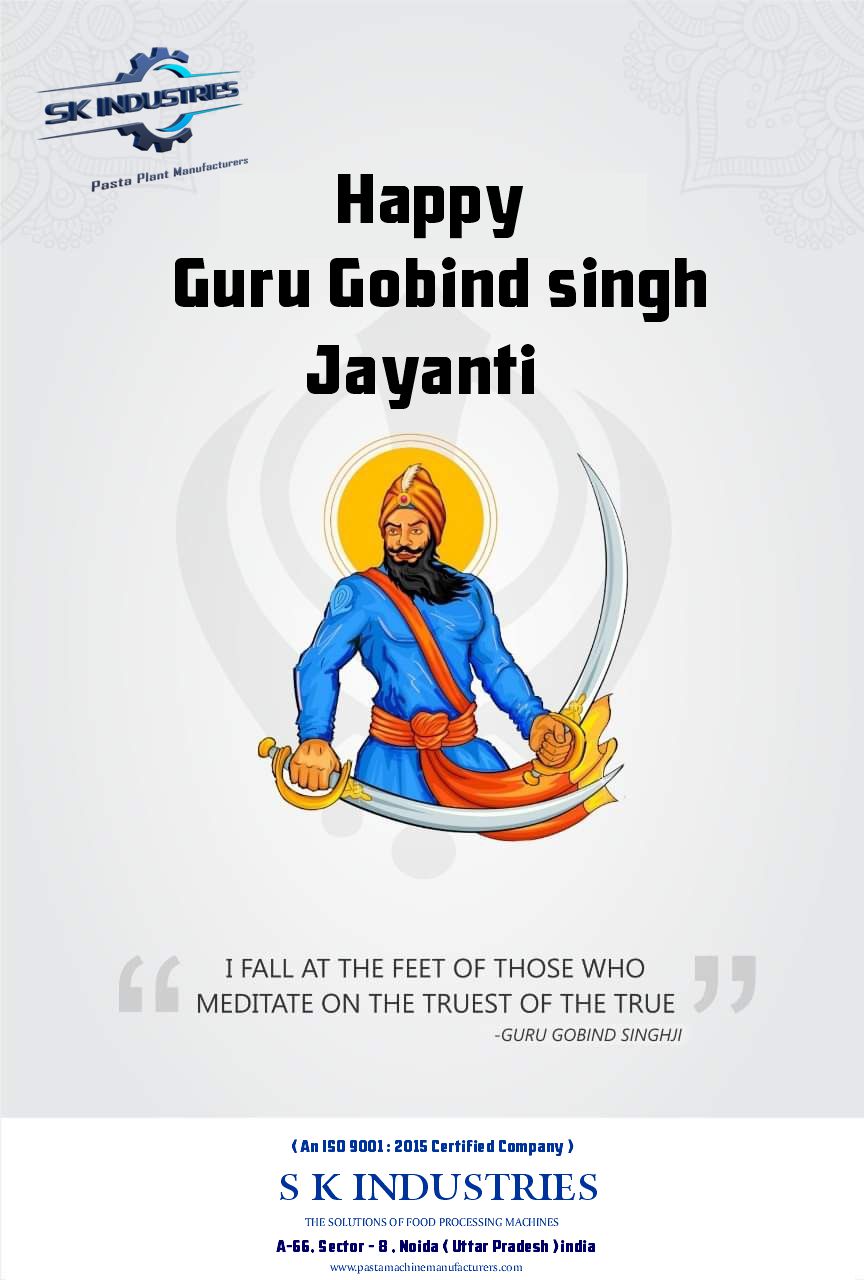Happy Guru Gobind Singh Jayanti Guru Gobind Singh ( 22 December 1666 – 7 October 1708), born Gobind Rai, was the tenth Sikh Guru, a spiritual master, warrior, poet and philosopher. When his father, Guru Tegh Bahadur, was executed by Aurangzeb, Guru Gobind Singh was formally installed as the leader of the Sikhs at the age of nine, becoming the tenth and final human Sikh Guru. His four sons died during his lifetime – two in battle, two executed by the Mughal army. Among his notable contributions to Sikhism are founding the Sikh warrior community called Khalsa in 1699 and introducing the Five Ks, the five articles of faith that Khalsa Sikhs wear at all times. Guru Gobind Singh is credited with the Dasam Granth whose hymns are a sacred part of Sikh prayers and Khalsa rituals. He is also credited as the one who finalized and enshrined the Guru Granth Sahib as Sikhism's primary scripture and eternal Guru. Gobind Singh was the only son of Guru Tegh Bahadur, the ninth Sikh guru, and Mata Gujri. He was born in Patna on 22 December 1666, Bihar in the Sodhi Khatri family while his father was visiting Bengal and Assam. His birth name was Gobind Rai, and a shrine named Takht Sri Patna Harimandar Sahib marks the site of the house where he was born and spent the first four years of his life. In 1670, his family returned to Punjab, and in March 1672 they moved to Chakk Nanaki in the Himalayan foothills of north India, called the Sivalik range, where he was schooled. His father Guru Tegh Bahadur was petitioned by Kashmiri Pandits in 1675 for protection from the fanatic persecution by Iftikar Khan, the Mughal governor of Kashmir under Mughal Emperor Aurangzeb. Tegh Bahadur considered a peaceful resolution by meeting Aurangzeb, but was cautioned by his advisors that his life may be at risk. The young Gobind Rai – to be known as Gobind Singh after 1699 – advised his father that no one was more worthy to lead and make a sacrifice than him. His father made the attempt, but was arrested then publicly beheaded in Delhi on 11 November 1675 under the orders of Aurangzeb for refusing to convert to Islam and the ongoing conflicts between Sikhism and the Islamic Empire. After this martyrdom, the young Gobind Rai was installed by the Sikhs as the tenth Sikh Guru on Vaisakhi on 29 March 1676.
Chat with us on WhatsApp
×
This is your website preview.
Currently it only shows your basic business info. Start adding relevant business details such as description, images and products or services to gain your customers attention by using Boost 360 android app / iOS App / web portal.

2021-01-20T06:39:11
Happy Guru Gobind Singh Jayanti Guru Gobind Singh ( 22 December 1666 – 7 October 1708), born Gobind Rai, was the tenth Sikh Guru, a spiritual master, warrior, poet and philosopher. When his father, Guru Tegh Bahadur, was executed by Aurangzeb, Guru Gobind Singh was formally installed as the leader of the Sikhs at the age of nine, becoming the tenth and final human Sikh Guru. His four sons died during his lifetime – two in battle, two executed by the Mughal army. Among his notable contributions to Sikhism are founding the Sikh warrior community called Khalsa in 1699 and introducing the Five Ks, the five articles of faith that Khalsa Sikhs wear at all times. Guru Gobind Singh is credited with the Dasam Granth whose hymns are a sacred part of Sikh prayers and Khalsa rituals. He is also credited as the one who finalized and enshrined the Guru Granth Sahib as Sikhism's primary scripture and eternal Guru. Gobind Singh was the only son of Guru Tegh Bahadur, the ninth Sikh guru, and Mata Gujri. He was born in Patna on 22 December 1666, Bihar in the Sodhi Khatri family while his father was visiting Bengal and Assam. His birth name was Gobind Rai, and a shrine named Takht Sri Patna Harimandar Sahib marks the site of the house where he was born and spent the first four years of his life. In 1670, his family returned to Punjab, and in March 1672 they moved to Chakk Nanaki in the Himalayan foothills of north India, called the Sivalik range, where he was schooled. His father Guru Tegh Bahadur was petitioned by Kashmiri Pandits in 1675 for protection from the fanatic persecution by Iftikar Khan, the Mughal governor of Kashmir under Mughal Emperor Aurangzeb. Tegh Bahadur considered a peaceful resolution by meeting Aurangzeb, but was cautioned by his advisors that his life may be at risk. The young Gobind Rai – to be known as Gobind Singh after 1699 – advised his father that no one was more worthy to lead and make a sacrifice than him. His father made the attempt, but was arrested then publicly beheaded in Delhi on 11 November 1675 under the orders of Aurangzeb for refusing to convert to Islam and the ongoing conflicts between Sikhism and the Islamic Empire. After this martyrdom, the young Gobind Rai was installed by the Sikhs as the tenth Sikh Guru on Vaisakhi on 29 March 1676.
2021-01-20T06:39:11

Submit Your Enquiry